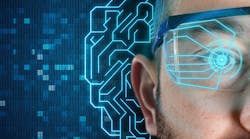To date, wearable tech has been deemed undeniably “consumer.” From the development of smartwatches, VR headsets, AR glasses, medical patches and more, technology is becoming increasingly convenient and accessorized for the consumer markets. In fact, the wearable industry is expected to hit a whopping $54 billion by the year 2023. This monumental growth is said to be attributed to developments in smartwatch capabilities—from cellular connectivity, health monitoring capabilities, contactless payment tech and more.
That said, there is a significant opportunity for enterprises, particularly supply chains, to capitalize on the wearable trend as well. Supply chain IoT devices have already become mainstream—assisting in shop-floor and back-end operations on a monumental scale. The integration of IoT has allowed for significant optimization of all processes, and in turn, has made overall operations more time and cost-efficient.
To further illustrate, the industrial IoT market is expected to reach over $750 billion by 2023. Wearables provide an opportunity to take these efficiencies to the next level. Especially with an already established dominance of industrial IoT, the next logical step is to integrate wearable convenience wherever possible.
What Are the Use Cases?
The potential use cases are seemingly limitless. Shop floor maintenance experts would be able to receive access to integral real-time data and alerts through push notifications—by connecting said wearable devices to shop-floor machinery. Pre-existing IoT device apps for enterprise can be optimized for wearable use—allowing for inventory management, aftermarket services, shop floor maintenance scheduling and more to be controlled from the convenience of the wrist. Unfortunately, studies have found that manufacturers are not as open to embracing risks that come with digital transformational success—and overhauling industrial IoT in favor of wearables is no small feat. These manufacturers will need to learn to embrace risk and invest heavily in the technology in order to truly benefit.
Field service technicians can reap the benefits of wearables as well. Today, these technicians rely on clunky tablets to be able to schedule, travel to, complete repairs on a daily basis. Wearable devices add a layer of convenience to field service duties—allowing for quicker communication with customers, agile on-scene mobility, and instant customer feedback. Even if wearables shave off a mere few seconds off each field service request, seconds add up quickly when considering the millions of repairs and analyses that one provider will need to conduct on any given day.
These are just a couple of the seemingly infinite ways that wearables can disrupt enterprise. Retail workers can utilize wearables to offer faster, more convenient customer service and in-turn convert more sales in-store. Healthcare providers can utilize wearables to instantly access important customer data and receive push notifications on patients in need of immediate assistance.
But beyond just the functionality of wearables, there is even more to benefit from.
Maximizing Wearable Data Usage
Similar to IoT devices in-place today, these wearable devices provide users with unparalleled access to a wide variety of data. The data gathered from one wearable device can influence business decisions and further optimize capabilities and processes from the ground-up.
For example, wearables on the shop floor can provide professionals with the information needed to understand how and when a machine part may need predictive maintenance or repair. The same wearable device understands what products or parts are in demand daily. If a manufacturer offers custom products or solutions, wearable devices can provide enterprises with real-time data to understand which custom preferences are valued by their customers. These enterprises can then take that information and develop new standard products and services that reflect the choices that their customers have made in the past.
In another instance, the data that is gathered from field service devices may inform enterprises on what problems are most-commonly arising with their products and services. That data can then be used to alter end-device capabilities and features to best-accommodate both the needs of the consumer and minimize the need for excessive maintenance and repair.
Especially when paired with technologies like AI and ML, enterprises will be able to find ways to make the most out of every single data point gathered using wearable devices.
Wearables are clearly popular among consumers, largely due to their unparalleled convenience. This convenience will soon be fully realized in the enterprise as well. Employees will benefit from the mobility and interoperability that comes with wearable devices, while enterprises will benefit from the massive amount of data that they will soon have access to as a result.
